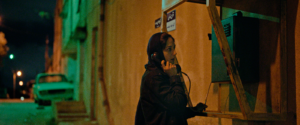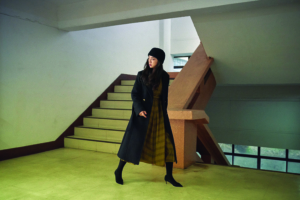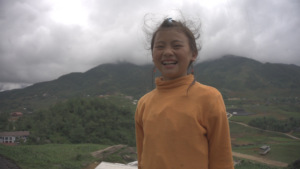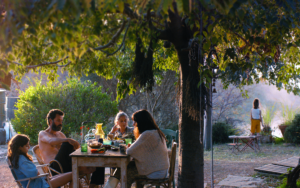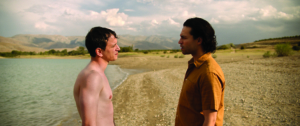Hirokazu Koreeda’s most recent film, Like Father, Like Son (2013), won the Jury Prize at the 2013 Cannes Film Festival, where Steven Spielberg picked up the rights for an American remake. This is unsurprising. A melancholy film about love and fatherhood, Like Father, Like Son strikes a similar emotional chord to some of Spielberg’s family-focused work. With a title that more closely translates from the Japanese to ‘Then to become a father’, the film follows the internal journey of Ryota Nonomiya (Masaharu Fukuyama), a conservative and hardworking young father who discovers that his son is not his biological offspring. Koreeda’s visual and rhythmic style allows him to explore the conflicting emotions that arise from such a charged situation without becoming overly sentimental.
The film draws on a timeless set-up. Two boys are born in the same hospital. A nurse, envious of the wealth and happiness of one of the mothers, swaps the babies. They are taken home by two very different families and grow up without knowledge of their origins. When the film begins, six-year-old Keita (Keita Ninomiya) lives as an only child in a high-rise apartment with gentle mother Midori (Machiko Ono) and Ryota, his architect father who works too hard to build the life he believes will most benefit his son. The other baby, Ryusei Saiki (Shōgen Hwang), is now an energetic older brother to two younger siblings. He lives in a ramshackle country house attached to his father’s mechanic shop. When the families discover their sons were swapped, they face a difficult decision: should the boys stay with the families they know, or should they be switched back to begin new lives with their respective biological families? The film then closely follows Ryota as he wrestles with questions of biology, love and success, gaining a deeper understanding of what it means to be a father in the process.

The plot verges on dramatic overabundance, but the events of Like Father, Like Son are more current and more common than they sound. This year, in South Africa, it was discovered that two four-year-old girls had been mistakenly switched at birth. When alerted to the situation, one mother wanted to swap the children back, while the other wanted to keep the child she knew.[1]David Smith, ‘South African Mother Refuses to Hand Back Switched Baby’, The Guardian, 29 May 2014 <http://www.theguardian.com/world/2014/may/28/south-african-mother-switched-baby/>, accessed 29 June 2014. In 2013, in Argentina, two babies were taken home by the wrong parents and switched back after a few weeks.[2]‘Argentine Mums Reunited with Babies’, SBS News, 24 October 2013, <http://www.sbs.com.au/news/article/2013/10/24/argentine-mums-reunited-babies/>, accessed 29 June 2014. In Siberia, two girls born in 1998 became the subject of a daytime television show; they were in their teens and had been brought up in vastly different households before they found out that they were not their respective parents’ biological offspring. The girls stayed with the families that raised them, but now visit their biological parents.[3]‘Our Babies Were Swapped at Birth 14 Years Ago and This Is How We’re Coping …’, The Siberian Times, 14 February 2013 <http://siberiantimes.com/other/others/features/our-babies-were-swapped-at-birth-14-years-ago-and-this-is-how-were-coping/>, accessed 29 June 2014. And last year, in Japan, a sixty-year-old man was paid US$371,000 in damages when it was revealed he had been taken home from the hospital by the wrong family. Although he had grown up poor, his birth parents were wealthy, so he sued the hospital for what he saw as stolen opportunities – the boy brought up by his biological family was university-educated, while he became a truck driver.[4]Arata Yamamoto & Alexander Smith, ‘Switched at Birth: Son Born to Rich Parents Sues Hospital after Life of Poverty’, NBC News, 30 November 2013, <http://www.nbcnews.com/news/other/switched-birth-son-born-rich-parents-sues-hospital-after-life-f2D11673222>, accessed 29 June 2014.
Ideas about the part that biology plays in who we become have shifted over time and vary across different cultures. However, it is evident from the news reporting of baby-swap stories that many of us consider biology to be an important marker of authenticity. The story of the Japanese man is framed as though another man was living his life, like an impostor. In Like Father, Like Son, Koreeda considers the question of biological connection and the cultural importance of bloodlines, but ultimately puts forward an idea he has explored throughout his oeuvre: that family is what we make it. Families, Koreeda suggests, are ever-changing and can consist of any number of people – biologically related or not; alive, dead or made of plastic – who support and love each other, sometimes in ways that are hard to make out. And like all of Koreeda’s work, Like Father, Like Son also explores aspects of contemporary life in Japan. Over its 121 minutes, it considers fatherhood, different visions of success, the relationship of work to prosperity, and how transformation can creep up on you even when you thought you had things all figured out.
Ideas about the part that biology plays in who we become have shifted over time and vary across different cultures … In Like Father, Like Son, Koreeda considers the question of biological connection and the cultural importance of bloodlines, but ultimately puts forward an idea he has explored throughout his oeuvre: that family is what we make it.
The film opens with a photograph of the Nonomiya family: Ryota and Midori, in similar navy-blue jackets, sit stiffly and look directly into the camera, while Keita stands upright between them. Below them is a thumbnail sketch of the photo, indicating each of their names. The shot cuts to a frontal wide shot of the family, sitting in a row on low chairs, looking anxiously ahead. It is Keita’s school entrance interview. ‘What is your favourite season?’ one of the examiners asks Keita, who responds, ‘Summer.’ And when asked what he did last summer, he recites seriously, ‘My father took me camping and we flew kites.’ The examiner follows this up with, ‘Is your father good at flying kites?’ to which Keita says, ‘Yes.’ Later in the film, Ryota comments, ‘I’ve never taken you camping, have I, Keita?’ His son replies, ‘No. The tutor told me to [say that],’ and Midori adds proudly, ‘You said your favourite food was my omelette, too.’ The scene sets up some of the conventions of middle-class Japanese families. Knowing what to say in the interview is more important than what going on holiday represents. Midori and Ryota are being tested just as much Keita – and not, I think, on their camping and relaxation skills. I imagine the examiners being perfectly aware of the rote answers, hearing them over and over, and judging them to be a good sign: the child’s parents care enough about his future to send him to cram school before taking the entrance exam.
Immediately following this is a joyous, fluid scene of schoolchildren making plastic-bag balloons with faces and hitting them into the air. They’re still being assessed but, absorbed in making their balloons, they’re no longer aware of it. When the session is over, Keita returns to his parents, who have been waiting in a large, empty foyer at the top of a stairway. They leave, and the camera lingers on the space, with its polished floor, long windows and spiral staircase positioned so the visual exit point leads into the depth of the screen rather than off to the side. Through this point, we enter the film.

In this opening sequence, Koreeda establishes his fascination with rooms, and with the corridors, roads, elevators and staircases that link them. As the story progresses and Ryota emerges as the central character, the film focuses on his arc and the emotional and ideological changes he goes through. Eventually, he will realise that, related by blood or not, he loves Keita more than he can imagine. And, to support Ryota’s trajectory, the film’s flow is constructed from a series of key shots inside rooms, connected by the transitional spaces between them. It is a structure that develops the film’s central mood of intimacy and interior change.
For example, when Midori and Ryota receive the results of the DNA test that confirms Keita is not their biological son, we hear the letter being read out as the camera rises very slowly over a long staircase. The shot is positioned to look straight down the staircase’s central cavity. Around the edge, partly obscured by the flights above them, Ryota and Midori are climbing – Ryota striding ahead shaking out an umbrella, and Midori hurrying along a few steps behind. The shot visualises the emotional impact of the news, the staircase leading them from one way of understanding their family to another. Soon after, there are three driving sequences shot as though looking through the windscreen and with the frame rate slowed slightly. First, the car passes through a tunnel; the shot is very dark, marked only by a string of tiny lights. Then it moves along a double-level freeway and, finally, curves around a ramp, the screen’s depth blocked off by a high concrete barrier. The slow motion and the camera’s restricted view – by light, by the walls of the ramp – convey concisely the sensation of the shock that follows a life-altering event. The slow journey leads to Ryota and Midori’s first meeting with the Saikis. Their differences are clear from the outset. The Saikis are late, and Yudai (Lily Franky) is casually dressed – a contrast to Ryota in his stiff suit. The photo they present of Ryusei is one of him on a water slide; the Nonomiyas offer a formal portrait of Keita, his hair neatly brushed and his face unsmiling.
To support Ryota’s trajectory, the film’s flow is constructed from a series of key shots inside rooms, connected by the transitional spaces between them. It is a structure that develops the film’s central mood of intimacy and interior change.
After the meeting, Ryota and Midori return to Midori’s mother’s house. Unlike their bright, Western-style apartment, the grandmother’s house is semitraditional, with sliding screen doors and tatami matting. Keita is asleep. In a shot that is barely lit – the middle of the screen is in darkness, with two thin bands of light at the doorway and window, dividing the screen into smaller blocks and intensifying the energy at the centre of the image – Ryota and Midori watch their son sleep. Midori gently strokes Keita’s head. Ryota wonders whether he might feel more connected to his son if they were biologically related, but is drawn towards him all the same. This brief moment is a clue to Ryota’s emotional investment in Keita. Although, unlike Midori, whose tactile relationship with Keita actively performs her affections, Ryota hasn’t yet become aware of his feelings, the film demonstrates his love. This shot – along with an earlier moment of the family lying together in bed, and a later scene of Ryota and Keita in a small bubble-like merry-go-round – build a cocoon of intimacy around the Nonomiyas, even as Ryota’s conservative ideas threaten to disrupt it.

In an interview with Sydney Levine, Koreeda observes that the importance we place on biology is influenced by our cultural circumstances, and that bloodlines are still important to some in Japan. Korean viewers, he notes, are even more likely to support the sons switching to live with their biological families permanently.[5]Sydney Levine, ‘Interview with Hirokazu Kore-eda, Director of Like Father, Like Son’, SydneysBuzz, Indiewire, 21 November 2013<http://blogs.indiewire.com/sydneylevine/interview-with-hirokazu-kore-eda-director-of-like-father-like-son-international-film-business/>, accessed 29 June 2014.
In this light, Ryota’s struggle represents not only his own emotional development, but also the struggle between traditional and more modern ways of thinking in a rapidly changing culture. In Ryota’s view, his own blended family, with his father and stepmother, is unstable, the source of his brother’s problems – we never find out exactly what they are, just that Ryota regards his brother as a failure – and unlikely to lead to the kind of socially conservative success he desires for his son. However, after the boys are swapped and he begins to try and see Ryusei as his son, he starts to question his tightly constructed view of what makes a good family.
The two families share several outings together, until they eventually agree to swap the children permanently. The final meeting takes place in one of the film’s few exterior settings, in the countryside by a river. In a long shot of Ryota and Keita, shot from behind as they crouch by the water’s edge, Ryota tells Keita that Ryusei’s mother and father also love him very much. ‘More than you do, Daddy?’ Keita asks. ‘Yes,’ replies Ryota. It is a heartbreaking moment, and Koreeda captures the intensity by keeping the camera back, away from their faces, and almost immediately cutting to an interruption – they are all going to have a group photo. The use of distance in emotional moments allows Koreeda to delve into potentially melodramatic territory without becoming cheesy.
After some difficult weeks during which the boys spend time with their new families, it becomes clear that switching children is not going to be easy. Ryota tries hard to be a more playful father with Ryusei, but Ryusei clearly misses his home. One evening, Ryota discovers photographs taken by Keita on his camera. They are all of him caught unaware – sleeping and working. Overcome by the open love with which children make images of their parents, Ryota’s transformation is complete. In the next shot, the Nonomiyas’ car travels slowly back to the Saikis’ home. That the photographs affect Ryota so deeply is moving and honest. So, too, is Keita’s initial resentment when Ryota turns up to take him home. In the penultimate sequence, Keita walks through an open mall and along a bridge, Ryota following him some distance behind. The mall shot – with Keita a tiny, trundling figure against a large empty shopping strip – captures the mood of the film’s final message. Our lives are crowded with difficult emotions, and how we confront them makes us who we are. Keita’s resilience and kind heart will eventually lead him to the success Ryota so desires for him. When father and son return to the house, the two families merge as they go inside. Division does not serve love, and so they come together – a different kind of family.
http://soshitechichininaru.gaga.ne.jp
Endnotes
| 1 | David Smith, ‘South African Mother Refuses to Hand Back Switched Baby’, The Guardian, 29 May 2014 <http://www.theguardian.com/world/2014/may/28/south-african-mother-switched-baby/>, accessed 29 June 2014. |
|---|---|
| 2 | ‘Argentine Mums Reunited with Babies’, SBS News, 24 October 2013, <http://www.sbs.com.au/news/article/2013/10/24/argentine-mums-reunited-babies/>, accessed 29 June 2014. |
| 3 | ‘Our Babies Were Swapped at Birth 14 Years Ago and This Is How We’re Coping …’, The Siberian Times, 14 February 2013 <http://siberiantimes.com/other/others/features/our-babies-were-swapped-at-birth-14-years-ago-and-this-is-how-were-coping/>, accessed 29 June 2014. |
| 4 | Arata Yamamoto & Alexander Smith, ‘Switched at Birth: Son Born to Rich Parents Sues Hospital after Life of Poverty’, NBC News, 30 November 2013, <http://www.nbcnews.com/news/other/switched-birth-son-born-rich-parents-sues-hospital-after-life-f2D11673222>, accessed 29 June 2014. |
| 5 | Sydney Levine, ‘Interview with Hirokazu Kore-eda, Director of Like Father, Like Son’, SydneysBuzz, Indiewire, 21 November 2013<http://blogs.indiewire.com/sydneylevine/interview-with-hirokazu-kore-eda-director-of-like-father-like-son-international-film-business/>, accessed 29 June 2014. |

